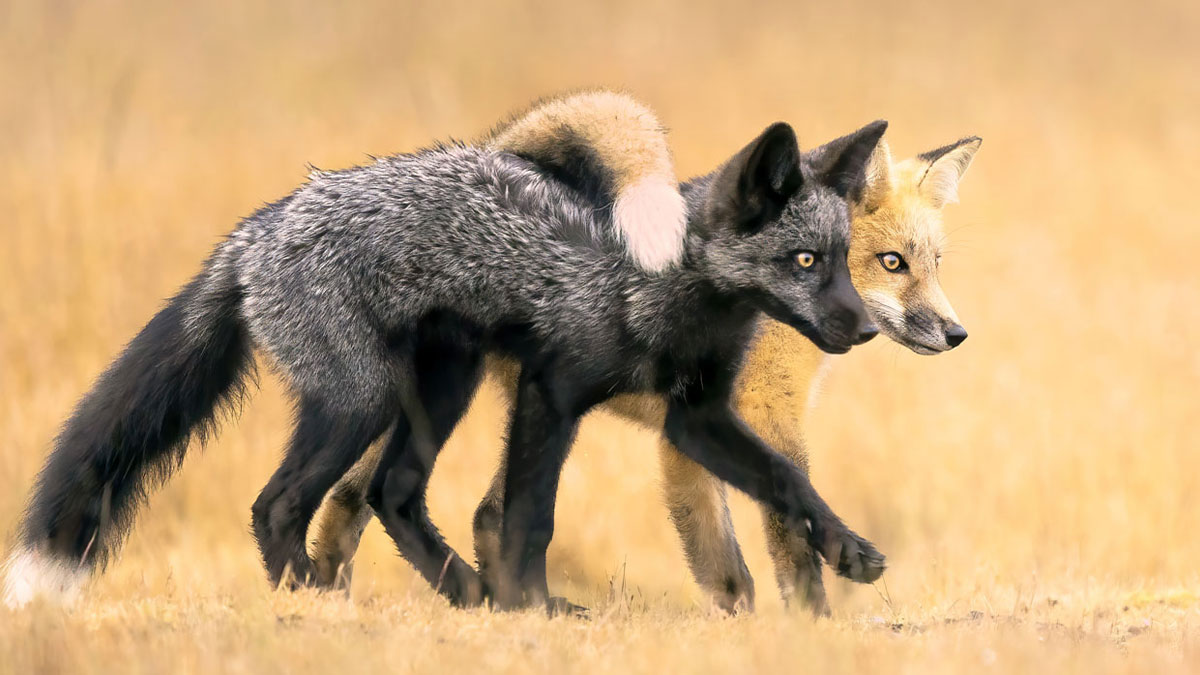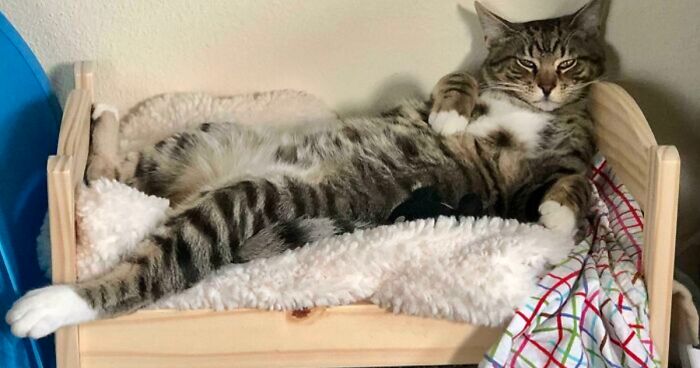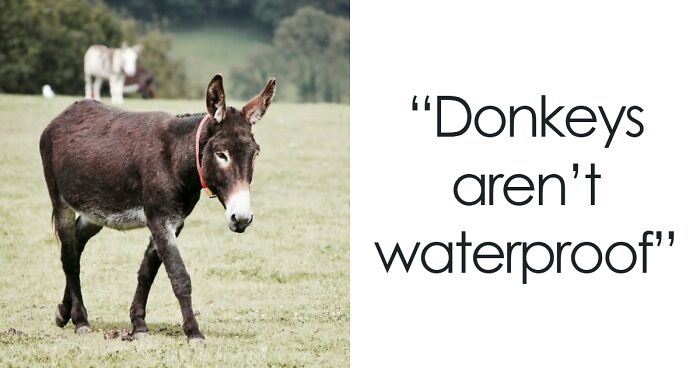
24Kviews
The Nature Photographer Of The Year: 30 Captivating Images From The 2024 Contest
InterviewThe winners of the Nature Photographer of the Year (NPOTY) 2024 competition have been announced! This prestigious event celebrates the very best in nature photography, showcasing stunning work from talented photographers around the globe.
Italian photographer Paolo Della Rocca has been named the overall winner, earning the title of Nature Photographer of the Year 2024 for his photograph "Games Between Siblings" featuring two snow leopards in a dramatic confrontation.
The competition is organized by Nature Talks, the team behind the annual Nature Talks Photo Festival in the Netherlands. The festival features a wide range of photography styles, including macro, landscape, underwater, wildlife, and storytelling, along with inspiring talks, live Q&A sessions, and workshops. The Nature Talks Photo Festival 2024 took place on December 14th, 2024.
More info: naturephotographeroftheyear.com | Instagram | Facebook
This post may include affiliate links.
Category Animals Portraits: Category Winner, "Besties" By Marcia Walters
"These spring fox siblings were walking together side by side in the evening. It was quiet, just these 2 fox kits and myself. I stayed at a low level. They slowly moved closer to each other. As they were walking, the tawny male kit threw his tail over the back of the female silver-phase kit. He then gently pulled her towards him using his tail. I can only think of this behavior as a show of affection. It lasted for less than a minute. They then slowly separated and continued to walk together.
I have been observing and photographing Red Foxes for 13 years. I enjoy capturing images that show their essence and their different behaviors. My goal is that the images are impactful to those who see them. This particular behavior is one that I have not seen prior or since this day. I have seen them since, on rare occasions, flip their tails over another fox but more as a playful gesture and not what I observed here, it looked to me like an affectionate hug.
Image was taken in NW Washington State."
NPOTY Chairman Tin Man Lee explains the jury's decision to select "Games Between Siblings" as the winning image: “In this extraordinary photograph, the photographer has captured what many consider the holy grail of wildlife photography—not just one, but two snow leopards in a dramatic confrontation. The image freezes a breathtaking moment as these elusive cats rear up on their hind legs, their powerful forms perfectly separated against the snowy landscape, creating a scene of raw power and natural drama.
What elevates this image beyond a mere sighting is the technical excellence in capturing such explosive behavior in challenging mountain conditions, combined with the artistic merit of a composition that places these mysterious cats in their ethereal, high-altitude habitat.”
Winner Category Mammals And Overall Winner Npoty 2024: "Games Between Siblings" By Paolo Della Rocca
"In northern India lies Spiti Valley, a land of rugged beauty and home to one of the most elusive creatures on Earth: the snow leopard. For me, this journey has been a lifelong dream, as the snow leopard has always been my favorite wild animal.
This year, my dream came to life during an unforgettable encounter with a pair of sub-adult snow leopard siblings. I had the privilege of observing and photographing them at various moments in their lives, capturing their grace and playfulness through my lens.
The pinnacle of this extraordinary adventure came on the first of February. Achieving the image I had envisioned was no easy feat. I waited for over six hours at the edge of a canyon, braving temperatures plummeting to -25°C and a relentless snowstorm that chilled me to the bone. The two siblings had been resting in a cave, and I could only hope they would eventually emerge.
When the storm subsided and calm returned, they began to stir. What unfolded next was beyond my wildest imagination. They climbed upward, chasing each other along snowy slopes, playing with a joy and vitality that left me awestruck. I remember whispering to myself repeatedly, “This can’t be real, it’s too incredible to be true!”
And then came the moment. A frame so perfect, so alive, that even in my wildest dreams, I couldn’t have imagined capturing it. This image, and the experience behind it, will forever remain etched in my memory as one of the most magical days of my life."
Category Mammals: Highly Commended, "Gone Fishing" By Hannes Lochner
"A small-spotted genet visits a water pond for a sip and glimpses a cluster of small carp swimming below the water’s surface. These elusive creatures are adept hunters of various prey: fish, frogs, mammals, birds, eggs, reptiles, and amphibians, and they have a penchant for fruits, insects, and forest-floor mushrooms. My aim was to unite these realms, above and below, by installing a camera, multiple light sources, and a gentle glow beneath the water. The aspiration was to capture the essence of autumn leaves, perhaps even encountering a fish or two if fortune smiled. As two worlds converged, an image I had dedicated over a year to crystallized before me – a testament to the fusion of these contrasting yet harmonious environments, triggered with a motion sensor.
I tried this image for years on bigger game, but most of the gear was either killed or dragged away never to be seen again. I got lucky with the small genet. Just interested in the moving of the fish, and drinking water."
The overall winner, Paolo Della Rocca, mentioned that he never even dreamed of capturing such a moment. "I’m so glad and grateful that the jury of NPOTY 2024 appreciated this photograph!”
Category Underwater: Category Winner, "Giant Octopus Dofleini" By Andrey Shpatak
"The Giant Pacific Octopus (Enteroctopus dofleini) stands out strikingly from other octopus species. It is highly intelligent and almost person-like in its behavior. Underwater, I’ve encountered both aggressive octopuses that attempted to defend their territory and sociable ones that even demonstrated their hunting techniques.
Once, at a depth of 20 meters, I encountered an octopus lying calmly on the seabed. It noticed me, seemed to realize that I had seen it as well, and began to swim toward the surface. Naturally, I didn’t follow it.
In this instance, the reef wasn’t particularly deep, and the octopus wasn’t especially large, about 1.5 meters in arm span and weighing around 5-7 kg. During the day, they often attach themselves to the reef wall, blending in by mimicking its color, and they rest while occasionally snacking on leftovers from their nighttime hunts. On this occasion, upon noticing me, the octopus decided to flee, swimming away while I managed to capture a few photos."
Category Other Animals: Category Winner, "Disturbing Shadow" By Sebastien Blomme
"Less than 5 kilometers from my home in Toulouse, France, I am fortunate to encounter one of the most fascinating insects in our local fauna: the Empusa pennata. Throughout the year, I observe it in its larval form, watching its slow and discreet movements among the grass and branches. The camouflage it uses to blend with its surroundings is remarkable, making each sighting feel like a small triumph. Its stick-like body and subtle, calculated motions allow it to stay hidden from predators and human eyes alike, making it a challenge to spot, but a rewarding experience when found.
But when May arrives, an even more extraordinary spectacle takes place: the emergence of adult empuses. My attention turns to the males, unmistakable with their feather-like antennae. These antennae are more than just an adornment; they are highly specialized sensors, capable of detecting female pheromones in the air, essential for the species’ reproduction and survival. The beauty of their interaction, largely unseen by most, is captivating. As I document these insects, I am struck by how their delicate existence goes unnoticed in our rapidly changing environment.
For this image, I positioned myself where the sun was just rising on the horizon, casting a golden glow across the landscape. I used the soft morning light to emphasize the silhouette of the Empusa pennata, capturing a shadow that feels both majestic and slightly eerie. Its slender, elongated body is sharply outlined against the backdrop, evoking a sense of both fragility and strength, a reminder of the uniqueness of this species. No special techniques were used; this is a single exposure.
Empuses, though present even in urban settings, prefer untamed wastelands. Sadly, these spaces are increasingly disappearing due to urban sprawl. Through my photography, I hope to raise awareness of the need to protect these vital habitats."
According to the organizers, among the other winners, runners-up, and highly commended entries, several notable names from the world of nature photography stood out. Thomas Vijayan was celebrated in the Birds category, Aaron Gekoski stood out in the Human and Nature category, and Paul Goldstein earned recognition in the Black and White category.
Category Youth: Runner-Up, "Milky Way" By Ismael Domínguez
"One night, it struck me to experiment with a long exposure while using a flash. To my surprise, a small bat appeared in the frame, flying through the scene. Inspired by this, we set the flash to strobe mode, allowing us to capture the bat multiple times in a single image, all while the Milky Way provided a stunning backdrop. The result was achieved using a carefully executed long exposure."
Category Birds: Highly Commended, "Surfing On The Other Side" By Levi Fitze
"In 2022, I had the privilege of traveling to the Falkland Islands in South America. During my two-week stay, I had the opportunity to observe and study the behavior of the four common penguin species found in the Falklands. At one location, I observed Gentoo Penguins returning from their hunts in the open sea, riding the waves as they came ashore. That moment inspired the image I had in mind, and I spent two afternoons attempting to photograph this behavior. Gentoo Penguins are the fastest swimmers among penguins, and they proved to be skilled surfers, even riding the waves on the other side."
Members of this year’s judging panel included:
● Tin Man Lee (USA), chair of the judging panel;
● Marco Gaiotti (Italy);
● Kevin Morgans (UK);
● Joan de la Malla (Spain);
● Barbara Dall’Angelo (Italy).
Category Nature Art: Category Winner, "Amino Acids Mimicking Nature" By Dirk Vermaire
"In the last five years I have been experimenting with growing crystals, using amongst others amino acids, and photographing them with the purpose of creating images that appeal to the imagination. This image, using alanine, glutamine, and N-acetyl L-cysteine, reminds me of strange sea anemones dancing in a ray of sunlight with little fish swimming around them.
Amino acids are the stuff of life, as they are the building blocks for the proteins in all living creatures. Proteins provide structure, regulate body processes, transport materials and do a host of other things without which life would be impossible. All this thanks to the 23 amino acids that life makes use of, of which I used three in the creation of this image.
Once the crystals have been prepared, I scan the crystals with the camera under cross-polarized light for interesting and appealing compositions. Some preparations show very regular patterns and may yield abstract images. Very irregular crystallization patterns offer a better chance of finding a more organic looking composition like the one in this photo. A crystal preparation is just like a landscape, you must walk through it and look at different orientations to find something of interest.
However, there are many preparations that are not interesting and then I clean the petri dish and start over again.
The crystals are made in a petri dish and are always translucent, but you can see the crystal patterns. However, if you want them to stand out, cross-polarized light is needed. To do that a led light is placed behind the crystals and a polarizing filter is placed before and after the crystals. By turning one of the polarizing filters the different crystal structures can be made visible. I used a polycarbonate plate between the crystals and the second polarizing filter to add more color to the image.
The image is stacked, as the petri dish in which the crystals are formed, is nearly never perfectly flat or parallel to the sensor, and the dof is extremely thin at 3x magnification and an aperture of 4."
Category Underwater: Highly Commended, "Stinging Elegance" By Franco Banfi
"I spotted this wonderful but stinging and dangerous Portuguese man o’ war with its commensal bluebottle fishes, while I was looking for a different species (sperm whales) in the warm water of the Caribbean Sea.
I was attracted by the frantic movements of the tiny bluebottle fishes, which swim close to the surface and among the tentacles of the Portuguese man o’ war, since they are partially immune to the stinging tentacles’ venom which discourages predators, hence they benefit from the shelter provided.
Although these fishes seem to be ten times more resistant to the toxin than other fishes, they can be stung by the dactylozooides (large tentacles), which they actively avoid.
The almost transparent gas-filled bladder of the Portuguese man o’ war, the colours, ranging from pink, to purple, to violet in total contrast with the clear blue of the marine water made for a delicate portrait.
The innate grace and elegance of this animal (especially the bladder, the upper / aerial part) are in total opposition to the danger of the nematocysts’ venom (found along the tentacles, on the underwater part). Nematocysts trigger and inject venom on contact, stinging, paralyzing, and killing molluscs and fishes, and cause severe pain to humans. On some level, the Portuguese man o’ war perfectly represents the opposition between good and evil; the forces of good and evil that are inherent in every living being.
I framed the elaborate shape, carefully approaching from below the surface to see and to be able to avoid the tentacles."
Category Mammals: Highly Commended, "Curious Guanaco" By Charles Janson
"It was -20C, so cold that we were engulfed in dense frozen fog. We were driving to find a puma to photograph in a private ranch near Torres del Paine National Park in Chile. I asked our guide to stop at a beautiful vista of the famous Towers (Torres). We got out and I set up to photograph the dramatic spires nestled in frozen fog. When I was just about to take my landscape photo, a guanaco (Lama guanicoe) appeared over the crest of the hill, intruding on my pristine setting.
I waited for a few minutes to see if the animal might leave, but soon another one appeared, and then several more. Making a virtue of necessity, I thought about how the guanacos could complement the landscape. Zooming out to include the foreground, I took a series of pictures as the guanacos approached.
I had owned several llamas (the domesticated descendants of guanacos), so I was familiar with their behavior. I could tell that the animals were not stressed as we stayed still on the road. Indeed, the lead animal showed all the signs of being curious, just like llamas. As it approached, I waited for the moment that it balanced the rest of the scene and took this picture.
As often happens with wildlife photography, the moment was a mixture of preparation and luck (good and bad). The bad luck was that the previous day, I had dropped my main camera and fancy telephoto lens on the road, rendering both of them useless. I was prepared for such an event, with a backup camera body and a mid-range (70-200mm) lens. Unable to take closeup portraits or even detailed behavior images, I started to imagine compositions where the animal was a small part of a wider landscape. Having practiced this enforced perspective for a day, I was better prepared to react to the good luck of guanacos ‘spoiling’ my landscape photo."
Category Animals Portraits: Highly Commended, "Emerald Gem" By Louis Guillot
"For eight months, from November 2023 to July 2024, I lived in the heart of the Peruvian Amazon rainforest in Madre de Dios. Volunteering with tourist lodges and conservation NGOs allowed me to immerse myself in this incredible ecosystem, documenting its wildlife and experiencing unforgettable moments. One of those moments came after a grueling nine-hour trek outside the Tambopata National Reserve.
As the day ended, I climbed a canopy tower to witness a breathtaking sunset over the endless expanse of jungle. Once the sun dipped below the horizon, fatigue and dehydration began to set in, and I was eager to return to camp. But as I walked along the trail with my headlamp on, a flash of vivid green about five meters away stopped me in my tracks. The intensity of the color seemed almost unreal. Intrigued, I moved closer, and my heart raced as I realized what I was seeing: an emerald tree boa, the snake of my dreams.
For five months, I had searched for this arboreal jewel during countless night walks. And here it was, just 1.5 meters above the ground, low enough to allow for perfect photography. My exhaustion was replaced by a rush of adrenaline and pure joy. This was my moment.
Despite feeling dizzy and drained after 10 hours of trekking without water, I knew I had to make the most of this opportunity. I pulled out my camera and flash, ready to capture this rare sight. The jungle had other plans, though: mosquitoes descended upon me in relentless swarms. Over 40 minutes, I amassed more than 150 bites across my body, including my face, lips, and ears. The discomfort was extreme, but I hardly cared. I had just found the treasure of the rainforest. In fact, I grew to appreciate the mosquitoes, as they added a sense of authenticity to the image.
Using a 15mm fisheye lens and an off-camera flash, I worked carefully to avoid disturbing the snake. Instead of setting up a tripod, which might have shifted vegetation and startled the boa, I handheld my camera and flash. I clipped a small torch to a nearby plant to aid with focusing in the pitch-black jungle. Then came the waiting game: I wanted to capture the snake in its natural environment, its tongue flicking out, with mosquitoes in flight around it.
Patience paid off. Eventually, I captured the perfect shot, an emerald tree boa with its tongue extended, framed by two mosquitoes in the foreground and two in the background. It was a rollercoaster of a night, but one I’ll never forget.
In post I made a mask and increased the exposure on the mosquitoes to make them more visible. More generally I increased the exposure of the whole photo as my flash didn’t fire at the correct power when I took the photo."
Category Landscape: Highly Commended, "Yggdrasill" By Matteo Strassera
The myth of Iceland as a wild, inaccessible land, home to untameable natural forces, was born in me long before my passion for photography. For years, I delved into researching this country in intricate detail, meticulously planning my adventure among its waterfalls, glaciers, and wind-swept deserts.
When news and photos of the first eruption in Iceland reached me in 2021, I was astonished. I had never imagined it would be possible to photograph such a force of nature! Determined to turn my research into reality, I decided to organize a photographic trip to Iceland the following year. From that moment, my journey became a true hunt for eruptions.
I traveled to Iceland in July, only to find that the eruption had ended. Just 10 days after my return, another eruption began. Undeterred, I decided to return in September, but once again, the eruption had ended before I arrived.
After two more trips, in July 2023, new reports from Iceland began to surface: the earth was shaking! Hundreds, even thousands of tremors followed each other for days. For two weeks, I anxiously waited, uncertain whether the activity would subside or if the earth would open up once more. Finally, I decided to take the chance and leave for Iceland, hoping for something extraordinary.
As soon as my plane touched down, my phone lit up with notifications: the eruption had started just before I landed!
I immediately rushed to the site, carrying 20kg of gear on my back, with 12km to trek and no idea what awaited me. What I witnessed and experienced over the four days I spent photographing this incredible force of nature, is both unforgettable and indescribable.
For this particular image, captured during the eruption of Litli-Hrùtur, I chose the name Yggdrasill. In Norse mythology, Yggdrasill represents the cosmic tree whose roots sink deep into the underworld, while its branches extend to support the worlds, giving them life.
Being in a country so steeped in myths and legends, faced with a phenomenon both awe-inspiring and terrifying, I couldn’t help but see the resemblance.
The 'roots' of the volcano extend deep underground through the eruption’s crater, just as Yggdrasill’s roots delve into the underworld. From these roots, a mighty river of lava emerges, forming a 'trunk' that splits into numerous branches resembling a glowing crown of molten rock. These golden, radiant streams, like Yggdrasill’s branches, create, sustain, and transform the world around us."
Um, how do you pronounce that? (anyway i'd say it's a cool photo, but it's quite literally molten rock.)
Category Black And White: Runner-Up, "Observed" By Luca Lorenz
"A lovely black redstart was singing from our neighbor’s chimney, its song so clear that I could hardly hear anything else, save for the deep, subliminal rumble of Berlin in the distance. Every morning, long before sunrise, it sings in the dark, keeping me company when I wake up early.
This morning, I left home with just my camera in hand and headed straight to my favorite nature spot. Even as a nine-year-old, I used to hide there, watching animals in secret.
The air was foggy, quite cold, and dusk had already fallen as I walked along a small path through the area. A blackbird hopped in front of me, foraging for insects. The mystical atmosphere surrounding it, made me want to capture the scene. I lay down flat in the morning dew-damp grass for a better angle when, suddenly, four fallow deer emerged from the bushes right in front of me and paused on the path.
We all stood still, observing each other, my heart pounding as it often does when encountering wild animals. The blackbird then moved between me and the fallow deer, and for a moment, we all seemed connected.
A bit too excited to operate my camera perfectly, I managed to capture this beautiful moment just before the fallow deer slipped back into the bushes."
Category Other Animals: Highly Commended, "Taken By A Ghost" By Pandora Maund
"I had originally hoped to return to South Africa in 2023 for another safari, but that didn’t pan out. However, a friend invited me to join her family in the Seychelles for a couple of weeks. Having never been before, I wasn’t quite sure what to expect in terms of wildlife photography. I reached out to the ICS (Island Conservation Society) team on the island and mentioned that I would be on Desroches Island for a couple of weeks. I offered to provide any photography services and get involved with any conservation projects while I was there. After working with the Giant Aldabra Tortoises, I was invited to join an early morning beach patrol to monitor bird species and track where turtles had come from the sea overnight to lay their eggs on the beach.
I had hoped to witness and photograph turtle hatchlings making their way to the sea as the sun rose. The hatchlings instinctively wait until the sand cools, indicating nighttime, when there’s less risk of predation. As the sun rises, they use its light to guide them to the sea and as far away from shore as possible, where predation is highest. Unfortunately, only around 1 in 1000 hatchlings survive to adulthood. Once they leave the nest, predators such as birds, ghost crabs, and fish pose a significant threat.
Ghost crabs are abundant on the beach, scavenging anything from fallen fruit and plants to decaying animals—and unfortunately, live turtle hatchlings. As I walked along the beach, I spotted several horned ghost crabs. One of them had something in its claws, and I realized it had caught one of the stragglers on its first journey to the sea. I immediately lay flat on the sand and switched my lens to a 300mm (600mm equivalent) prime. The crab was scuttling along the beach, dropping its prize and picking it up again. I waited patiently until it turned to face me, capturing the shot. Though it’s difficult to identify the species of the turtle, it was likely a critically endangered Hawksbill, which can be found around this remote island."
Category Landscape: Highly Commended, "Fogfall At Belchen" By André Schweizer
"The area where this picture was taken is close to where I live in the Swiss Jura. I always go to this location because there are various photo spots nearby to take great photos. It is also an excellent place to take photos of fog waves. Autumn and winter in particular are the ideal season to take fog pictures. However, ideal weather conditions must prevail for a fog wave to form. The upper limit of the fog, the temperature and the wind direction are key points, but the shape of the mountain ridge must also be right.
This morning in front of the Alpine chain, everything was just right and the first rays of sunshine also made the little snow on the trees in the foreground shine like gold. To show the flow of the fog, I took a long exposure of 4 seconds.
I often use fog as a design element to catch the viewer’s attention and make them take a closer look at the picture. Many more fog pictures can be seen on my homepage and I invite you to visit my website."
Category Animals Portraits: Highly Commended, "Puff(In) Daddy" By Brian Matthews
"Atlantic Puffins (Fratercula arctica) prepare to depart the coasts and islands of the UK in late July. Before they leave, these charismatic seabirds gather in vast “rafts,” sometimes numbering thousands. For the past four years, I’ve been traveling across the UK to document the wildlife that thrives along its coasts and islands as part of a major biodiversity, climate change, and education project.
Not far from my home lie the Farne Islands in Northumberland, northeast England, an internationally significant seabird breeding site hosting 100,000 puffins. The islands are one of my favorite places to visit. To capture a unique perspective, I had custom puffin decoys created and collaborated with local boat operator Billy Shiel. His son, Olly, took me out for early morning sessions, helping me immerse myself within the puffin rafts. The approach worked, allowing me to capture rare images of puffins in the North Sea, including this remarkable shot of a puffin perched atop a wave.
Protecting the waters surrounding these islands is vital for the survival of puffins and other seabirds. Recently, the UK implemented a ban on industrial sandeel fishing, a move aimed at balancing the needs of marine wildlife and the fishing industry. Over the next decade, we’ll discover whether this decision helps ease the challenges these remarkable birds face, particularly as they contend with rising sea temperatures caused by climate change."
Category Birds: Runner-Up, "Shorebird Hunt" By Nick Dunlop
"I have been photographing raptors for over 50 years with an emphasis on Peregrine Falcons which are common where I live. I began by photographing them nesting and raising their young which was fun and satisfying. Once nesting season was over I was looking for something to do and began frequenting local marshes and bays where I had seen peregrines during the fall and winter months. These locations were “stopover” places where migratory shorebirds would rest and feed on their way south and provided a food source for peregrines.
Spending days and weeks at the marsh gave me a chance for images but most of the action was far away with no access across the mud flats. I got stuck in the mud more than a few times! But it got me hooked in trying to get images of hunting falcons. I could accompany falconers flying their birds but I wanted wild birds hunting in natural settings. Easier said than done! Doing research and speaking to biologists gave me ideas of where to go along the west coast of California, Oregon and Washington and I began traveling in search of migratory flocks of shorebirds.
Eventually I found a few locations where my chances of success improved and spent most of my time there. I found quickly that the larger the flock, the better chance it would attract a falcon. I learned to stay close to the flock, but not too close as to scare them off. And most of the time I went alone. Then it was a waiting game. Most days I never saw any action or got poor results. But persistence paid off for my image here as I guessed right and was in the right place at the right time to get an intimate shot of a hunting peregrine inside a flock of shorebirds.
The image was taken on a secluded beach near the Oregon and Washington state line. The scientific name of the Peregrine Falcon in the image is known as Falco peregrinus pealei, and shorebirds are Dunlins, Calidris alpine.
I shoot handheld with autofocus on. Using a tripod is too cumbersome and I only use it when shooting video. Exposure is set to manual and I constantly check my settings as the light changes. Sony autofocus is fantastic and was “sticky” enough to keep the peregrine in focus in the midst of thousands of shorebirds."
Category Human And Nature: Highly Commended, "Bed Time" By Gerard Carbonell
"Niete is a recently rescued chimpanzee (Pan troglodytes) saved from a poacher who intended to sell her as a pet, while her family was killed for bushmeat. When young chimpanzees lose their mothers before their eyes, they experience trauma and require extensive care and compassion to be rehabilitated. A dedicated team of caregivers is now providing round-the-clock attention to Niete at the Limbe Wildlife Centre, a rescue and rehabilitation center focused on the unique species of Cameroon.
Rebuilding a bond of trust with a chimpanzee requires immense love and commitment. In this image, Niete has fallen asleep in the arms of Godlove after her bottle of warm milk at night. Godlove spends entire nights holding her close as she grows bigger, stronger, and confident enough to eventually be introduced to other chimpanzees rescued from the bushmeat trade."
Category Nature Of “De Lage Landen”: Highly Commended, "Deer In Golden Light" By Richard Guijt
"The Amsterdamse Waterleidingduinen, a nature reserve in the Netherlands, plays a vital role in purifying drinking water for the city of Amsterdam. This unique area is also home to a thriving population of European fallow deer (Dama dama). Living near this reserve allows me to visit frequently and explore its natural beauty.
On this particular morning, the reserve was shrouded in a hazy atmosphere, especially around the many small canals that wind through the landscape. As I wandered the area in search of subjects, I noticed a fallow deer standing still atop a dune. The deer’s motionless posture, combined with the misty surroundings, created a striking scene.
Carefully, I positioned myself to frame the deer without any visual distractions. At the same time, I aligned my shot to block the sun and diffract its light, enhancing the dreamy quality of the moment. The result was a serene image that encapsulates the tranquil beauty of this special reserve."
Category Black And White: Highly Commended, "Stray Birds" By Minghui Yuan
"At Wuhan’s East Lake, I often sit beneath the branches of this dragon jujube tree. The branches twist and meander upward in strange, beautiful shapes, adding a sense of abstraction and wonder to the scene. As I rest under the tree, I sometimes see one or two birds flying overhead. I waited patiently, hoping for the perfect moment to capture a larger group of birds soaring past. Perhaps my endless waiting paid off, as suddenly, a flock of migratory birds flew over these branches and vanished into the sky.
Life defies logic; it’s full of unexpected moments and beauty. To capture this scene, I used a super wide-angle lens. I held the camera with live view mode to enhance the visual extension effect and capture the full, sweeping view overhead."
Category Animals Portraits: Runner-Up, "Another Perspective" By Oscar Diez Martinez
"While photographing white-tailed eagles along Norway’s central coast near Flatanger, I noticed that herring gulls often flew close to the boat, unbothered by our presence. Their boldness was remarkable, they would even perch on my hat! Seizing the opportunity, I switched to a wide-angle lens and captured this unique shot while one perched confidently on my head, resulting in a striking and unconventional perspective."
"hellos hooman, it seems I may be sitting on ze shiny blinky thing that makes a clicky noise"
Category Underwater: Runner-Up, "Love In The Deep" By Luca Luigi Mario Ghezzi
"The Adda River, which flows near my home, is the body of water I know best. I often go snorkeling here, trying to capture fish through my lens. One day, I decided to focus on the European catfish (Silurus glanis), an invasive and predatory species that has spread through the Lombard waters in recent decades and now thrives throughout the Po basin. These non-native species have a significant impact on local biodiversity, causing the decline of native species and disrupting the balance of ecosystems.
I went to an area known for the presence of these fish, even though they are difficult to spot during the day. That day, however, I was lucky: beneath a pile of logs deposited on the riverbed, I spotted the shape of a fish. As I submerged to try to photograph it, I was surprised to discover that there were two. The two European catfish seemed to be embracing tenderly, and the pile of logs formed a natural frame, creating an image reminiscent of a pair of newlyweds.
When I surfaced, I carefully reviewed the shots, hoping that at least one was well-lit and managed to capture the scene I had just witnessed on the muddy riverbed."
Category Human And Nature: Category Winner, "My Pet Tiger" By Aaron Gekoski
"For more than three years, I’ve been working on a documentary about our complex relationship with big cats, titled Dethroned. This journey has taken us around the world in an effort to understand how we have shifted from respecting and revering big cats to consuming and exploiting them.
One segment of the film focuses on the exotic pet trade. Fueled by social media, the trade in big cats is thriving in Pakistan, where owners clamor to possess rare and dangerous animals such as lions, leopards, and tigers. Some are imported from South Africa, while others are bred locally.
In a bid to understand what drives someone to keep a big cat as a pet, we met a big cat owner in Karachi who had a tiger cub named Zorro. Zorro was particularly timid and disliked attention. However, for about a minute, he sat still, eyes fixed on the camera, before quickly retreating under the sofa, allowing me to capture this image.
The combination of eye contact and his frightened expression, paired with the opulent surroundings where he seemed to blend in so seamlessly, created a striking and memorable image. The contrast to his natural jungle home couldn’t be starker.
When the cubs grow too large to keep at home, they are often moved to other facilities for the safety of their owners. While keeping a big cat as a pet may look ‘cool’ online, in reality, it poses a danger to both people and animals."
This absolutely makes my blood boil. And I can't believe there are more tigers in CAPTIVITY (pets, acting as 'guards' for d**g dens etc) in the USA than in the wild >.<
Category Mammals: Runner-Up, "The Path To Bath" By Lakshitha Karunarathna
"After being playful with mud and dust, a herd of Sri Lankan elephants walks towards a waterhole on their daily path. The darker elephant in the middle had just returned from a solo bath and decided to join the gang anyway, to return to the waterhole and have some fun again. I was mostly documenting the elephants’ disastrous relationship with uncontrolled garbage dumps in Sri Lanka’s Eastern province, and I noticed that at the end of each day, most of the elephants walk to the water holes, which are located near the fragmented forest blocks, where the elephants rest at night and during the day when the temperatures are too high.
Despite the fact that elephants hold the symbolic, cultural, and economic importance in Sri Lanka, a steep decline of this endangered sub-species of the Asian elephant family has been observed, particularly in the last decade. Poaching for ivory, conflicts with humans over the destruction of property and crops, electrocutions through illegal fencing, and irregular garbage dumps have all contributed to the threats in the existence of Sri Lankan elephants, but the greatest threat to their survival is an expanding human population and its demand for land.
Significant areas of elephant range are still being lost to development, with a number of irrigation and development projects, resulting in the conversion of more elephant ranges to irrigated agriculture and settlements."
Category Nature Of “De Lage Landen”: Runner-Up,
De Lage Landen translates as the Low countries in Dutch, so The Netherlands and Flanders ( A part of Belgium)
Category Other Animals: Highly Commended, "A Graceful Flight" By Litauszki Tibor
"An Antlion flies in the summer night over the Hungarian steppe. At the end of July, as evening falls, they begin their mating flight in masses. I wanted to capture this moment. To show the dynamics of their movement, I chose a long exposure time of zero point three seconds. I followed the antlion with a LED lamp, manually adjusting the focus on the lens. The flash flashed on the second curtain.
Thanks to the long exposure time and the LED lamp, the flapping of the wings can be seen. And finally, the flash froze the antlion. I spent a total of 10 evenings with them, taking over 10,000 pictures. But maybe only 10 turned out well. This is one of my favorites."
Category Nature Of “De Lage Landen”: Category Winner, "Colorful Seagull" By Mathijs Frenken
"Nature can also be found in urban areas, especially if there is water and food to be found. There is no shortage of water in the Amsterdam canals. Opportunistic animals such as birds in particular make grateful use of all that water and the food scraps that people leave behind.
Birds in the city are generally a lot less shy than their counterparts in the countryside or in the woods. This makes them easier to approach and therefore easy to photograph. This black-headed gull swam back and forth in a canal Amsterdam in the hope of finding something tasty to eat. The reflection of a colorful billboard could be seen in the water surface. I hoped that the gull would swim through the reflection so that I could capture it among all those colors. After some patience, the gull did what I wanted and I was able to take this colorful photo."
Category Human And Nature: Runner-Up, "A Dangerous Addiction" By Lakshitha Karunarathna
"A Sri Lankan elephant scavenging at a waste site in the Eastern district of Ampara serves as a stark visual reminder of the dire consequences of improper waste management practices on an island that is home to about one-tenth of the world’s Asian elephant population. Revered symbols of strength and wisdom, elephants are reduced to foraging through hazardous rubbish, highlighting the urgent need for sustainable waste solutions. Elephants often visit garbage dumps not only for easy meals but also to find a substantial amount of starchy items that they enjoy once accustomed to the taste.
The chaotic and erratic handling of waste in Sri Lanka has resulted in serious and catastrophic environmental problems. Numerous verified accounts exist of elephant deaths caused by the ingestion of microplastics and polythene, which the animals mistake for food at disposal sites. Over the last decade, there has been a sharp increase in such cases, significantly impacting the survival of the Sri Lankan subspecies of elephants, which are classified as ‘Endangered.’ They are already experiencing a rapid population decline due to poaching for ivory, conflicts with humans over property and crop destruction, electrocutions from illegal fencing, and the pressures of an expanding human population demanding land.
I began documenting the adverse impacts of the massive waste sites in the Eastern Province on elephants approximately two years ago. The choice of subject is significant, as Sri Lanka is one of the most important habitats for Asian elephants. With more than 10% of the global Asian elephant population living in less than 2% of the known elephant range, Sri Lanka has the highest density of elephants among range countries.
In my photo-documentation efforts, I have utilized various techniques and equipment, including drones, action cameras, camera traps, remote triggers, and even simple mobile hides, allowing me to get close to the large herds of wild elephants that feast on fresh garbage almost every day. As a firm believer in the importance of photography in conservation, my ultimate goal is to capture the attention of authorities and the general public by publicizing my photo stories, thereby pressuring officials to adopt better waste management practices, beginning with relocating larger dumping sites away from significant forested areas."
Category Youth: Highly Commended, "Lonely" By Angelina Widmann
"There is a mute swan colony at Jägersee that I often visit, particularly in winter. The lake’s biodiversity is limited, so I usually focus on photographing the swans. Being a mountain lake, Jägersee is frequently blanketed in snow, as it was on this visit. Initially, I used a telephoto lens to capture images of the lone swan visible that day. While the photos turned out well, they lacked a certain vibrancy. I then switched to a portrait lens with an open aperture to capture the icy landscape and freeze the motion of the falling snowflakes. The resulting image is very atmospheric and recreates the atmospheric cold of the day."
Category Youth: Category Winner, "Brace!" By D’artagnan Sprengel
These were wonderful! I am especially excited to see that the chair of the judging panel was Tin Man Lee, one of my favourite photographers ever!
I had to quit this thread. The constant ads make it impossible to read with the text and pics bouncing up and down. BP is really going downhill...
One only has to click through one ad. Try Cheezburger, now that's a gong show.
Load More Replies...Great photography. My favorite is the pet tiger. What a contrast between the wild and opulence.
These were wonderful! I am especially excited to see that the chair of the judging panel was Tin Man Lee, one of my favourite photographers ever!
I had to quit this thread. The constant ads make it impossible to read with the text and pics bouncing up and down. BP is really going downhill...
One only has to click through one ad. Try Cheezburger, now that's a gong show.
Load More Replies...Great photography. My favorite is the pet tiger. What a contrast between the wild and opulence.

 Dark Mode
Dark Mode 

 No fees, cancel anytime
No fees, cancel anytime 














































































































